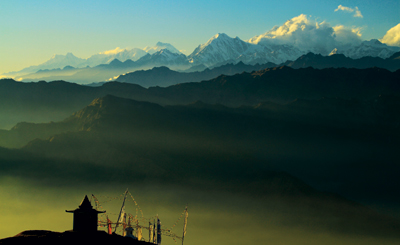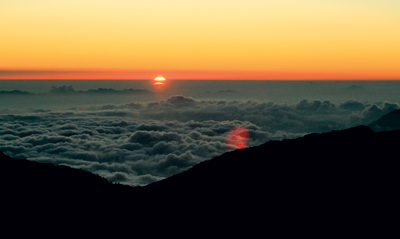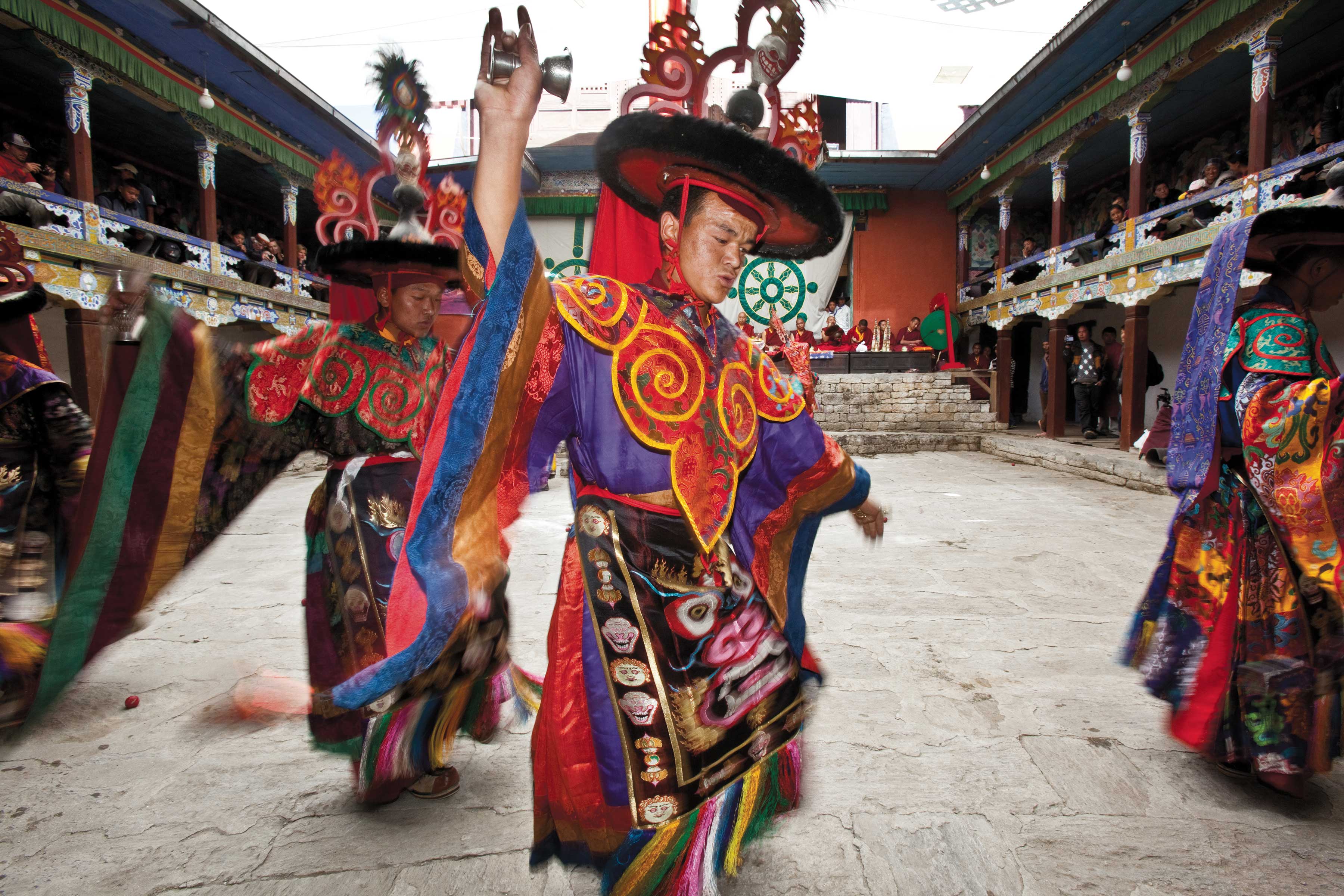 I remember the first picture I saw of Gosaikunda – a friend posing against the lake and a wild icy mountainous background. It brought to mind two things – its religious significance told yearly in the stories of the Swasthani, of its creation by Lord Shiva - that, and a longing for the wild, tranquil beauty of that place – a need to be out there. These two, incidentally are the reasons people go to Gosaikunda – the former, in the span of a week around Janai Purnima (purnima means full moon and janai is a religious thread worn by Hindu men) brings thousands of people who come to wash away their sins and change their janais. The latter brings Gosaikunda and Nepal most of its tourists spread across the ideal months for trekking, February - May and September - November.
I remember the first picture I saw of Gosaikunda – a friend posing against the lake and a wild icy mountainous background. It brought to mind two things – its religious significance told yearly in the stories of the Swasthani, of its creation by Lord Shiva - that, and a longing for the wild, tranquil beauty of that place – a need to be out there. These two, incidentally are the reasons people go to Gosaikunda – the former, in the span of a week around Janai Purnima (purnima means full moon and janai is a religious thread worn by Hindu men) brings thousands of people who come to wash away their sins and change their janais. The latter brings Gosaikunda and Nepal most of its tourists spread across the ideal months for trekking, February - May and September - November.
My friends and I however, mixed the two together – we went for the mountains, but we went towards the end of August and got to Gosaikunda on Janai Purnima - as did thousands and thousands of other people. This is where you have to remember that Gosaikunda is essentially in the middle of nowhere with a limited number of lodges which gives you a very simple reason why you should normally not go trekking there around Janai Purnima – it’s very, very expensive. Here’s an example – ‘Room for the night please - That will be 6,000 rupees.’ And no, this isn’t some fancy hotel, just a normal lodge in Gosaikunda on Janai Purnima. Thousands of people, limited rooms – put your economic hats on about demand and supply and it makes sense. Oh, and if it makes you feel better, a day earlier it was 3000 rupees.

Gosaikunda Lake in all her glory.
Lessons to be Learnt
My friends and I, smart bunch that we were – we took tents and sleeping bags – and spent the coldest, wettest night of our lives trying not to freeze as the cold wind and the rain tested our already failing tents (word of advice – check tents before for waterproofness). We slept, survived, and in a way, it is an accomplishment.
There are two other impacts that result from the sheer number of people who go to Gosaikunda; the first being a sense of violation of your idea of free space that you attach to such remote places and secondly, the terrible condition that the walking trails are in. Add rain to the latter and millions of footsteps and you get muddy, slippery and very dangerous walking conditions. Add to that, darkness, and you get a small picture of the perils of our trek from Gosaikunda down to Dhunche. Trekking essentials realized – Torches! Lesson learned – start early in the morning. We left Gosaikunda at about 11am and got to Dhunche at about 1am, almost 14 hours later, walking hours in the darkness, in the rain, unable to move as fast or as slow as we wanted because we were walking single file with either ill or injured people. Gosaikunda is at around 4400m above sea level and the dangers of altitude sickness (or AMS- Acute Mountain Sickness) are very real – dedicated army officers rushing sick people down to Dhunche was a frequent and scary sight, and a gentle reminder of the unforgiving harshness of being in the mountains. Watch out for its symptoms - shortness of breath, headaches, dizziness, appetite loss and nausea. PLEASE drink water – lots of it.
The Power of Faith
I’m not trying to put you off if you are indeed considering going to Gosaikunda for religious reasons – it is a journey full of hardship, but also an experience unmatched in spirituality. The sight of women and men – old, frail, struggling and yet carrying their bodies and offerings up the mountain, driven – you have to see it to understand for I cannot explain the power of faith except perhaps to say that the greater the hardship, the greater the catharsis at the end. In that numbing cold, people pray, wash and bathe in the freezing water of the pond, and maybe the little oxygen in the air addled my brains but I had woken up with a terrible headache from the cold of the night in Gosaikunda - it went away when I immersed my head in the pond.
For those who go to Gosaikunda on a trek as opposed to a pilgrimage of sorts, the trek is special because of the wild beauty of it – spectacular views of Ganesh Himal, Manaslu and Annapurna, deep gorges, ravines, waterfalls - the place is itself an experience, the wonder of the view of mountains being a natural part of it. If the title hasn’t given you enough of a clue, we saw nothing of mountains during our entire trek, in fact we saw little of anything at all except mist, mist and more mist.
I try to imagine what my memories would be like if I’d seen the mountains we thought we’d see. My memories of that trek however, are still so rich, so full, if not by sights then by experiences. The mist does not mask beauty; it holds beauty in itself - landscapes and hills bathed in it, accentuated by a heavenly sense of being above the clouds.

The mist holds beauty in itself - landscapes and hills bathed in it, accentuated by a heavenly sense of being above the clouds.
The Trek
The trek to Gosaikunda starts at Dhunche, which is about a 7-hour drive from Kathmandu and costs about 320 rupees. Buses run every morning with a stop in Trishuli for lunch after which, for the last 50km of the journey, I recommend (perhaps slightly against regulations) riding on top of the bus instead of inside it. Be warned, you will realize exactly how much faith you’re putting into the driver’s hands and how utterly scary and high the roads are. It’s either that or you spend your time inside the bus listening to music, sleeping, making small talk or looking out to see what little you can. It is not enough to say that you get a different perspective from up top or that the views of gorges, waterfalls and the forests are stunning – the difference between being inside and on the top are akin roughly to moving of your free will and being transported while locked inside a cage. Word of advice, take your sleeping bag or something of that sort to sit on because the roads are very bumpy - I imagine it to be very similar to being on a bull in the rodeo.
Dhunche, your mini base camp is as urban as you can expect urban to be in Rasuwa at 3300m above sea level with hotels, shops, and even a bank and an ATM! It is where the easy ends and the real trek begins. We left Dhunche and started the slow walk uphill, camping in a place called Chandanbari on the first night where (as if out of nowhere) there is a dairy which sells cheese (500 rupees/kg). After a breakfast with cheese omelette (Yum!) we went on, stopping at Cholangpati for lunch (and because of heavy rain). Cholangpati, and the place after it called Laurebeena, are where most people start feeling the effects of the altitude. The transition is so prominent you can feel it in the air, and also if you notice, the vegetation, which is very sparse. The locals strongly advise against touching or smelling, as it is known to exacerbate altitude sickness. Laurebeena (lauro: stick, beena: without) is also the point of an interesting custom – people leave their walking stick as offering at the temple of Laurebinayak and walk without them to Gosaikunda where we arrived in the evening passing Saraswatikunda and Bhairavkunda (kunda means pond).
I’d like to interject at this point - while planning is essential for any trip, there is a thrill in randomness, in just going somewhere – an idea you can explore very freely in Gosaikunda given its close proximity to Langtang. You can tailor a trek from five days to over eighteen. Get off in the quaint little village of Syabrubesi instead of Dhunche in the same bus and you can explore Langtang instead - or you can go on a longer trek to both places, starting with Gosaikunda and moving on to Langtang and further. We originally intended to go further up above Gosaikunda to Suryakunda but couldn’t because of the heavy rain. It was then that we made the best decision of the trip – Tatopani, which ended up being a holiday within the trek. We wore ourselves out in the 14-hour descent to Dhunche and spent most of the following day recovering; sampling the local alcohol including tongba and took the bus in the evening to Syabrubesi – bliss!

A panorama that is unforgettable and will stay on in the mind’s eye for a long, long, time.
Counting the Costs
I’ll give you a small idea of costs for this trip and why it’s expensive at this time of the year. I have friends who went at other times and spent as little as 1200 rupees. The yearly influx of people around Janai Purnima is a more a way of life – families set up stalls along the way carrying everything from food to fuel to toilet paper (100 rupees for a roll). For most of the local people, this time represents their income for the whole year. The altitude and the costs go up in quiet agreement – meals cost around 200 rupees in Dhunche and go up to over 400 rupees in Gosaikunda. Tea, the necessary luxury, starts at 10 rupees and climbs up to 50 rupees (the tea itself gets weaker as you go up – tea bags are precious!). Alcohol, err, um...optional. I do however, strongly recommend a jhaikhutte – warmed alcohol flavoured with pepper and butter. Roughly, you’re looking at expenses of between 600-1000 rupees a day. This however is because the masses of people are concentrated only in Gosaikunda while the surrounding areas of Langtang and Syabrubesi and Tatopani are empty.
Tatopani, literally meaning hot water, is just that - a hot spring that flows though iron and copper rich rocks that supposedly give it healing properties made into three pools. It is about a four-six hour hike uphill from Syabrubesi which is an hour on the bus from Dhunche and costs about 60 rupees. The hike to Tatopani is easy, a simple walk in the wild with amazing views. When we went there that fine rainy day in August, it was absolutely empty – we had a whole lodge to ourselves for which we (group of four) paid 300 rupees. The local alcohol made from fermented millet was 30 rupees for a bottle and we had the hot spring all to ourselves.
An in Describable Experience
I am in no way exaggerating when I say that Tatopani has been till now one of the best experiences of my life. In fact, I cannot do it justice, which is why I will not describe the sensation. It is a personal experience for everyone. I will describe the setting, and leave your mind to imagine and for yourself to discover. Imagine if you can the feeling of finding an oasis in the desert after a hard day in the sun. It’s like that reaching this place after a hike in the cold rain - the feeling of being in hot spring in a light drizzle of rain - your body placed in the melt of two extremes - the coolness of the falling rain meeting the warmth of the burning hot water, amidst a quiet, calm, tranquil surrounding bathed in a sea of mist. So, if you want a cheap but amazing break and have four days, get on the bus from Kathmandu to Syabrubesi, staying there overnight, hike to Tatopani the next day, stay overnight, and follow the same for your return journey. There are other routes too, take the bus from Balaju to Syabrubesi and head over to the village of Gojlung the first day and to Tatopani via Gatlang on the second.
Descriptions are pointless, for nothing can match the experience of being out there, enjoying the solitude, revelling in the faith of the devotees, sipping a cup of tea or jhaikhutte in the cold, looking out into the wilderness that speaks if you learn to listen. My last bit of advice – invest in a good pair of walking boots, pack warm, pack light, pack waterproof and just go, go for the right reasons and the wrong. Go. For the mountains or for God, for freedom of space, a chance to discover yourself. Go. To test yourself, to find yourself, to lose yourself. Go. At the right time or wrong. Go!










